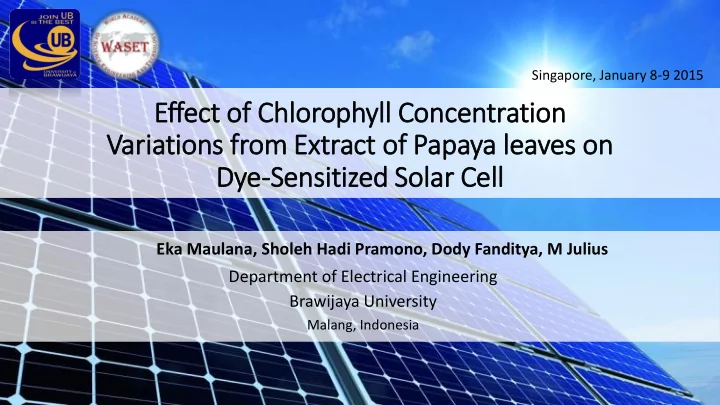

Singapore, January 8-9 2015 Effect of f Chlo lorophyll Concentration Vari riations fr from Ext xtract of f Papaya le leaves on Dye-Sensitized Solar Cell Eka Maulana, Sholeh Hadi Pramono, Dody Fanditya, M Julius Department of Electrical Engineering Brawijaya University Malang, Indonesia
Increasing Energy Demand Limitation of Energy resource Solar Energy Potentials Indonesia Geographically located in EQUATOR LINE (Solar radiation of 4.8 kW/m 2 /day) Ref. [3] Dye-Sensitized Solar Cell (DSSC) Solar Cell (Conventional) High cost Mimic photosynthesis approach Photo-electro-chemical phenomenon High temperature Natural Dye extracted from Papaya Leaves Clean room/ high tech
e - e - R e - LUMO e - Light hv hv HOMO e - TiO 2 TCO TCO DYE I - /I 3 - DSSC e - Photo-electrode Counter-electrode Basic Operation DSSC Basic Principle
Material & Method Counter Substrate Chlorophyll dye Preparation Electrode DSSC Structure TCO glass Photo Carbon coated Electrode glass Papaya leaves extract Variation of: Deposition of * Ratio Leaf & solvent Electrolyte * Solvent concentration TiO 2 & firing Preparation * Stirring time Immersion of TCO Dye Preparation DSSC assembly coated TiO 2 in dye & stirring process Measured by Electrode UV-Vis 1601 wiring (400-800 nm) DSSC Electrical Characteristic (I-V) measurement
Result #1 Measurement by y varia iation of the ratio io between le leaves mass and solv lvent volu lume Chlorophyll dye Absorbance Spectra #1 DSSC Electrical Characteristic Pmax Sample Chlorophyll Total Voc Isc (watt) (ratio) (mg/l) (mV) ( μA ) 112.64x10 -9 1:5 74.804 160.7 2.8 203x10 -9 2:5 75.895 203 4 824.64x10 -9 3:5 80.076 235.5 14 The maximum number of a , b , and total chlorophyll was achieved of 3:5. The highest absorbance spectra was obtained by ratio of 3:5 (along 500-700 nm wavelength). The electrical measurements imply that the 3:5 ratio was maximum open voltage and sort circuit current.
Result #2 Measurement by varia iation of ethanol solvent concentrations Chlorophyll dye Absorbance Spectra #2 DSSC Electrical Characteristic Pmax Solvent Chlorophyll Total Voc Isc (watt) (%) (mg/l) (mV) (μA) 279.07x10 -9 70 61.815 218.4 5.1 449.24x10 -9 80 75.067 224.2 8 824.64x10 -9 98 80.076 235.5 14 The highest absorbance spectra was obtained by concentration of 98%, 80% and 70%, respectively. The maximum chlorophyll total was achieved of 98% solvent concentration of 80.076 mg/l. The maximum open voltage and sort circuit current were obtained by 98% solvent concentration.
Result #3 Measurement by vari riation of f stir irring tim ime Chlorophyll dye Absorbance Spectra #3 Electrical Characteristic Pmax Stir time Chlorophyll Total Voc Isc (watt) (minutes) (mg/l) (mV) ( μA ) 824.64x10 -9 30 80.076 235.5 14 172x10 -9 120 75.895 191 3.6 119.97x10 -9 180 75.895 171 2.8 The highest absorbance spectra was obtained by stirring time of 30 minutes. The maximum chlorophyll total was achieved by 30 minutes stirring time of 80.076 mg/l. The maximum open voltage and sort circuit current were obtained by 30 minutes of 235,5 mV and 14 μ A, respectively.
Conclusion DSSC have been designed and characterized by following method: dye processing, TiO 2 paste, TiO 2 -coated TCO glass, firing substrate, immersion TiO 2 TCO substrate into dye solution, counter electrode processing, and fabrication of DSSC by active area of 1.8 x 1.8 cm. Refer to the variation of the ratio between leaves mass to solvent volume of 1:5, 2:5 and 3:5, it can be obtain the maximum chlorophyll number of 80.076 mg/l and fill factor of DSSC of 25% at ratio of 3:5. Variation of solvent concentration were used of 70%, 80% and 98%. It can be achieved that the output power of DSSC was 824.64x10 -9 watt at solvent concentration of 98%. The variation of stirring time of chlorophyll extract ware observed of 30, 120, and 180 minutes. The maximum chlorophyll number was achieved at 30 minutes by V oc and I sc of 235.5 mV and 14 μA , respectively.
References • A. Quan , “ Degradation of the Solar Cell Dye Sensitizer N719 Preliminary Building of Dye-Sensitized Solar Cell ”, Thesis, Denmark: Roskilde University, 2006. • S. Manan , “ Solar Energy as an Efficient Alternative Energy Resource in Indonesia ”, Thesis, Department of Electrical Engineering UNDIP, Semarang, unpublished, 2009. • Z. Xia, “ Characterization of the Dye-Sensitized Solar Cell ’. Degree of Bachelor of Science in Chemistry. Worcester Polytechnic Institute. (10), 2009. • O. Regan, M. Gratzel . “A Low Cost, High Efficiency Solar Cell Based on Dye -Sensitized Colloidal TiO 2 Films”. Nature 353. (737 – 739), 1991. • M. Syahid, et al ., “Recent Advancement in Natural Dye Application: A Review”. Journal of Cleaner Production . (1 – 22), 2013. • S. H. Pramono, E. Maulana. T. Utomo , “Organic Solar Cell based on extraction of Papaya ( Carica papaya ) and jatropha ( Ricinus communis ) leaves in DSSC (Dye Sensitized Solar Cell)”, Proceeding of International Conf. on Edu. Tech and Science, pp. 248-251, 2013. • R. Wang, K. Hashimoto, Nature 388, pp. 431, 1997. • M. Gratzel, Nature 409, pp. 575, 2001. • T. Ohtsuka, T. Otsuki, J. Electroanal. Chem. 473, pp. 272, 1999. • I. K. Ding, J. M. Kyriazi, N. L. Cevey-Ha, et. al , “Deposition of hole -transport materials in solid-state dye-sensitized solar cells by doctor- blading”, Organic Electronic vol. 11, pp. 1217-1222, 2011. • S. S. Kim, et al , “Annealing - free fabrication of P3HR:PCBM solar cell via simple brush painting”, Solar Energy Material and Solar Cell J . vol. 94, pp. 171-175, 2010. • V. W. W. Yam, WOLEDs and Organic Photovoltaics . New York: Springer-Verlag, 2010, ch. 1.
Recommend
More recommend